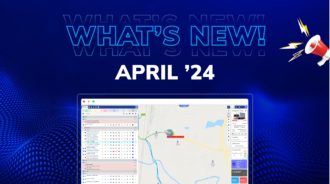In the fast-paced world of courier and delivery services, the implementation of advanced driver tracking software is revolutionizing the industry. With the global courier services market projected to be worth $400 billion by 2024, incorporating cutting-edge technology is not just a luxury, but a necessity for staying competitive and efficient. This blog delves into how driver tracking software plays a pivotal role in shaping the sector and connects to advanced fleet management systems, enhancing operations and customer satisfaction.
What is Driver Tracking Software?
Driver tracking software is a sophisticated technology system designed to enhance the efficiency and management of a fleet of drivers in real-time. It’s an integral part of modern logistics and plays a crucial role in streamlining operations in the courier and delivery industry. Here are some of the key features and functionalities of driver tracking software:
Real-Time Location Tracking
One of the primary functions of driver tracking software is to provide real-time location updates of drivers. This feature utilizes GPS technology to track and display the current location of each driver in the fleet. This information is critical for dispatchers to manage deliveries efficiently, reroute drivers in case of traffic or obstacles, and provide accurate delivery estimates to customers.
Route Optimization
The software often includes AI-powered route optimization. It analyzes various factors like traffic conditions, delivery windows, and vehicle capacity to suggest the most efficient routes.
Automated Dispatch and Order Assignment
Modern driver tracking systems can automate the process of order assignment. Based on the current location, availability, and capacity of drivers, the software can intelligently assign orders, reducing the manual effort needed for dispatching and balancing the workload among drivers.
Driver Performance Monitoring
It can monitor various aspects of driver behavior such as speed, idling time, braking patterns, and adherence to the planned route. This data is crucial for identifying areas where drivers may need additional training or guidance, ensuring compliance with safety standards, and maintaining efficient operations.
Enhanced Communication
The software often includes features for improved communication between dispatchers and drivers. This can include real-time updates, alerts, and messaging systems. Such features ensure that drivers are informed about any changes or specific instructions related to their deliveries.
Proof of Delivery and Documentation
Driver tracking software can facilitate digital proof of delivery, allowing drivers to capture signatures, images, or notes as evidence of completed deliveries. This feature streamlines the documentation process and provides a reliable record for future reference.
Integration with Fleet Management Systems
Driver tracking software can seamlessly integrate with broader fleet management systems. This integration allows for a comprehensive view of the entire delivery process, including vehicle maintenance schedules, driver availability, and delivery tracking.
By incorporating these features, driver tracking software significantly improves the operational efficiency of courier and delivery services. It enables companies to manage their fleets more effectively, ensure timely and accurate deliveries, and enhance overall customer satisfaction.
The Benefits of Driver Tracking in Courier Services
Enhanced Operational Efficiency
- Optimized Delivery Routes: Driver tracking software employs advanced algorithms for route planning, ensuring that drivers follow the most efficient paths. This not only reduces travel time and distance but also helps in avoiding traffic congestions. By optimizing routes, companies can ensure faster deliveries and serve more customers in less time.
- Real-Time Dispatch and Scheduling: The software allows for dynamic scheduling and dispatching. It adapts to real-time conditions, such as traffic updates or last-minute order changes, enabling dispatchers to make informed decisions and reassign tasks as needed. This flexibility significantly enhances the responsiveness of delivery operations.
Improved Driver Safety and Compliance
- Monitoring Driving Behavior: The software provides insights into drivers’ on-road behavior, such as speeding, harsh braking, or deviating from the assigned route. By identifying risky behaviors, companies can take proactive steps to ensure compliance with safety standards and reduce the likelihood of accidents.
- Ensuring Adherence to Regulations: Driver tracking helps in enforcing compliance with driving hours and rest breaks regulations. This is crucial for maintaining driver health and safety, as well as for adhering to legal requirements.
Cost Reduction and Resource Optimization
- Fuel Efficiency: By providing the most efficient routes and reducing unnecessary idling and detours, driver tracking software can significantly reduce fuel consumption, one of the major operational costs in the delivery sector.
- Maintenance Alerts: Advanced tracking systems can monitor vehicle health and provide timely alerts for maintenance needs. Regular maintenance helps in avoiding costly breakdowns and prolonging the lifespan of the vehicles.
Enhanced Customer Satisfaction
- Real-Time Delivery Tracking: Customers can track their deliveries in real-time, enhancing transparency and trust in the service. This feature is particularly valued in the e-commerce sector, where customers expect timely and accurate information about their orders.
- Accurate Delivery Estimates: By monitoring real-time conditions and driver progress, the software provides more accurate estimated times of arrival (ETAs), allowing customers to plan accordingly.
Data-Driven Decision Making
- Insightful Analytics: Driver tracking software accumulates a wealth of data that can be analyzed to uncover trends, identify areas for improvement, and inform strategic decisions. This data-driven approach enables companies to continuously refine their operations and stay ahead of the competition.
- Feedback Loop for Continuous Improvement: The software can provide feedback on driver performance, delivery times, and customer satisfaction. This information can be used to implement targeted improvements, train drivers, and enhance overall service quality.
Advanced Fleet Management: A Synergistic Approach
Integrating driver tracking software into advanced fleet management systems creates a synergistic approach, enhancing overall fleet performance. This integration allows for seamless management of driver activities, vehicle maintenance schedules, and efficient route planning, leading to an optimized delivery process.
Safety and Compliance through Driver Tracking
Driver tracking ensures compliance with safety regulations and company policies. Video-based telematics and monitoring systems allow managers to observe driver behavior, ensuring adherence to speed and safety regulations.
Cost Management and Efficiency
Efficient route planning, reduced idling times, and maintenance alerts contribute to significant cost savings. By optimizing delivery routes and driver performance, companies can reduce operational expenses while maintaining high service standards.
Enhancing Customer Experience with Real-Time Tracking
Providing customers with real-time tracking information and accurate ETAs is essential for customer satisfaction. Advanced tracking systems enable customers to monitor their deliveries, enhancing transparency and trust in the service.
Future Trends and Innovations in Driver Tracking
The future of driver tracking in the courier and delivery sector is promising, with innovations like RFID tags and QR codes for cargo tracking, crowdsourcing delivery, and truck platooning shaping the industry. These technologies aim to improve efficiency, reduce costs, and enhance customer experiences.
Conclusion
The integration of driver tracking software in courier and delivery services is a game-changer, significantly impacting efficiency, safety, cost management, and customer satisfaction. As the industry continues to evolve, embracing these technologies will be crucial for companies to remain competitive and meet the growing demands of the digital age.



